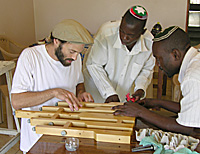By Diana Brement,
JTNews Columnist
Sculptor and glass artist Gabriel Bass, a Mercer Island native now living in Jerusalem, recently completed and installed a ner tamid (eternal light) and menorah commission for the Abayudaya Jewish community in Uganda.
The commission came from a California couple who are deeply involved with the Abayudaya. They “felt the synagogue needed an eternal light and turned to me for that,” Gabe says. (The menorah was added later.)
Gabe admits he’d never heard of the African Jews, but as soon as he started talking about the project, all sorts of connections revealed themselves.
“Doors just started opening left and right,” he says. Friends, neighbors, even clients had heard of, donated to, visited, and even worked with the Abayudaya.
“Support just started coming in,” and it didn’t take long for him to decide to perform the installation himself.
It was a long but uneventful 24-hour journey from Jerusalem to Kampala, with two layovers and a four-hour drive from the airport to the village. Gabe carried the works, “just to make sure” they arrived safely.
He stayed two weeks, visiting most of the local Jewish communities.
“They say there’s eight,” Gabe says, “but there’s different things happening, different communities cropping up, [other] people that are becoming Jewish.”
Both pieces are made of glass and wood from a single Israeli cypress tree. The ner tamid is red, black and yellow, the colors of the Ugandan flag. It runs on a battery attached to a solar collector, keeping it lit during the many blackouts and power shortages. “The synagogue is the only building with electricity,” in the villages, says Gabe. The menorah has glass fittings and oil lamps on tops.
Many villagers came to help install the project. The community has established a religious school, and “a lot of the yeshiva kids helped me,” Gabe says. “Everyone wanted to give a hand.” Then, that Shabbat “we had a really nice festive meal.”
Gabriel grew up on Mercer Island and his family attended Herzl-Ner Tamid Conservative Congregation (appropriately), although they moved away while he was in high school. He and his wife, Gabriela (Hammer), who also grew up at Herzl, re-met and married after college. They now live in Jerusalem with their two children. Gabe, who did some of his training with the Musqueam tribe of British Columbia, creates a lot of synagogue furniture and Judaica.
“About half my work is shipped back to the United States,” he says. Chabad of the Central Cascades recently purchased an aron kodesh (ark) from him.
See more of Gabe’s work at his Web site, www.customcarving.org, where you can learn how to visit his studio when you’re in Jerusalem. He’ll be in North America in November, speaking at the URJ biennial in Toronto, making other presentations and visiting clients in the Northeast.
|||
Last summer we received an e-mail from Esther Lott reporting that she and some of her family had run in the Swedish SummeRun 5K race, and that she had done quite well.
I was a little slow on the uptake, so by the time I called, Esther and her husband, Al, were away for the winter and we didn’t connect. This year I called early in the summer to see if she was running again. Indeed she was, and did on July 26.
“It was great,” she says, “I got first place in my category.”
However, at age 77, “I was the only one running!”
It’s not much to beat yourself, but Esther was gratified to learn that she had also bettered runners in the 60-and-up category with her time of 31 minutes.
“I got my gold medal in the mail,” she says. “That made me feel good.”
Esther ran with her daughter, Susan Solomon, and her granddaughter, Celina. In 2008, her grandson Bryan ran, too, but this year he was on the NESIYA program in Israel.
Esther has been running for 30 years, starting on the advice of her then-exercise teacher at the Stroum Jewish Community Center.
“All we were doing was aerobics,” but this teacher insisted the class jog for their hearts. The first day they jogged around the gym. “We gasped and gagged.” But the teacher insisted, “so I just kept doing it.”
Soon she could run 10 blocks. “Then I started going down to 40th and up Island Crest Way,” (she lives on Mercer Island). “People would honk…I would wave.”
Feeling better and losing weight were her rewards and it took her mind off “menial problems.” Eventually, she ran a 10k race, finishing second, then completed a half marathon.
From lectures and classes about running she concluded that shoes were the key to success and freedom from pain.
“I spend all my money on my shoes,” she says. “I don’t care about my clothes.”
She buys two pairs of shoes every three months, and alternates between them.
Esther has slowed down a little in retirement. Once a daily runner, she now runs three days a week, working out at the gym three other days. She has “probably belonged to every organization in the world,” and has been a volunteer for the SJCC, Kline Galland and Hadassah. She and Al have been long-time and active members of Herzl-Ner Tamid.
